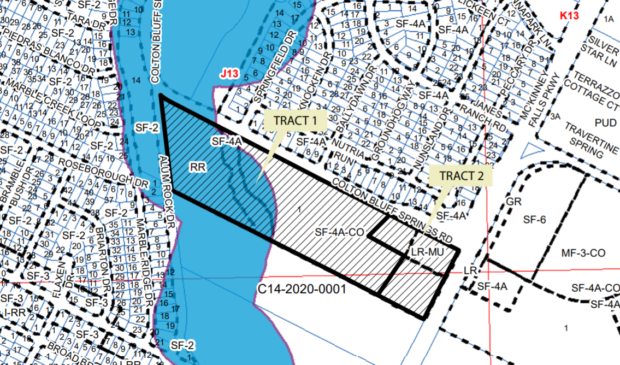Council to consider zoning for apartments near McKinney Falls
Thursday, April 9, 2020 by
Jo Clifton The lone zoning case City Council is likely to discuss today would allow a developer to build low-density apartments, as well as a small commercial development, on a 23-acre tract on Colton Bluff Springs Road in Southeast Austin near McKinney Falls Parkway.
Council gave first-round approval to the rezoning at its March 12 meeting. The vote was 7-2, with Council members Leslie Pool and Alison Alter opposed. Mayor Steve Adler and Council Member Greg Casar were off the dais and Mayor Pro Tem Delia Garza was conducting the meeting.
Attorney Jeff Howard, who represented the property owner, told Council in March that while his client had requested Multi-Family Residence – Medium Density (MF-3) on one tract and Community Commercial – Mixed-Use (GR-MU) on the other, he would be satisfied with the Zoning and Platting Commission’s recommendation. ZAP agreed with the commercial zoning but recommended MF-2, which allows a developer to build approximately 23 units per acre, as compared to 36 units per acre with MF-3.
Howard said the back third of the property is not able to be developed, “except for trails, which we intend to put in.” He said his client thinks that the staff recommendation of MF-3 is appropriate, but was willing to accept the ZAP recommendation of MF-2. He said the property is between two transit priority networks and close to a proposed park-and-ride location.
The lone witness objecting to the zoning change was Don Zdancewicz, who lives on Nutria Run, with the back of his property directly across the street from the property being rezoned. Zdancewicz started his list of complaints by enumerating the answers, or lack thereof, he has gotten about the future of the property. He said the zoning change would make the property incompatible with the surrounding neighborhood.
He objected to the commercial zoning, which would allow a height of 60 feet, while he and most of his neighbors have single-story homes, about a third of the commercial development’s height. Zdancewicz was also concerned about the number of units that would be developed on the property. He said the current zoning would only allow for about six units per acre, while the MF-3 zoning would allow for 36 units per acre and MF-2 would allow for four times as many units as are allowed under the current zoning.
According to Zdancewicz, Colton Bluff Springs Road is only 70 feet wide, though the staff report pegged it at 80 feet. He also complained about insufficient signage to stop or slow traffic on that street. His bottom-line objection was the amount of additional traffic that would be created by the proposed development.
In a conversation with Joi Harden of the Planning and Zoning Department, Council Member Jimmy Flannigan asked a number of questions about the difference between MF-2 and MF-3. He concluded that although the number of units per acre was slightly lower for MF-2, there was little difference between the two categories. Council Member Ann Kitchen followed up with another question about the difference. Howard explained that he represents the landowner, not the developer.
However, he said when they did the traffic impact analysis, the developer indicated there would be 144 units, more than ZAP wanted. Howard then quoted the late Betty Baker, longtime chair of the city’s Planning Commission and one of the great experts on Austin zoning. “As Betty Baker used to say, we don’t zone projects, we zone property. So, it would involve a conditional overlay to cap the number of units, and that might work with this particular developer but it may not be the best land use decision for the property.”
In order to address the concern about the number of units, Howard said, ZAP reduced the zoning from MF-3 to MF-2.
In the end, Kitchen asked Howard if he would get together with the neighbors before the case comes back to Council on second and third readings. Neither Howard nor Zdancewicz could be reached for comment Wednesday.
Map courtesy of the city of Austin.
The Austin Monitor’s work is made possible by donations from the community. Though our reporting covers donors from time to time, we are careful to keep business and editorial efforts separate while maintaining transparency. A complete list of donors is available here, and our code of ethics is explained here.
You're a community leader
And we’re honored you look to us for serious, in-depth news. You know a strong community needs local and dedicated watchdog reporting. We’re here for you and that won’t change. Now will you take the powerful next step and support our nonprofit news organization?









